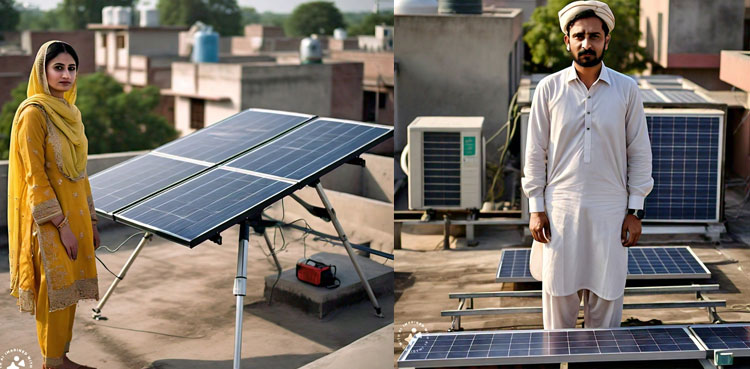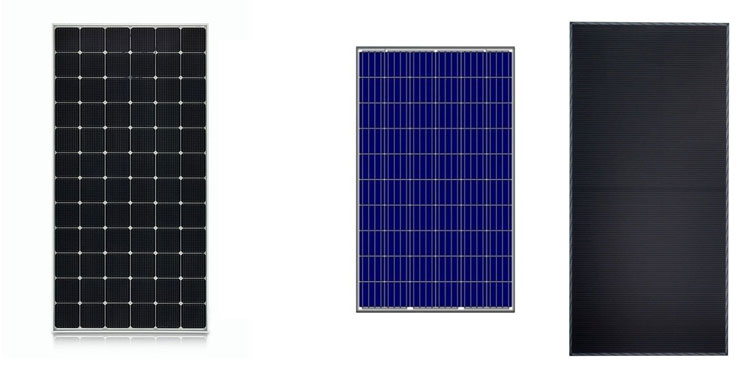
Solar Solution in Pakistan: All You Need To Know

A large number of Pakistanis are opting for solar energy due to rising cost of electricity and energy shortages.
According to World Bank, Pakistan has the potential to generate 40 GW of solar power, so the government is also introducing favorable policies and incentives to promote solar energy development, further fueling the shift towards this renewable energy source.
In this article, we’ll explore the three main types of solar panels: monocrystalline, polycrystalline, and thin film.

Monocrystalline Solar Panels
Monocrystalline solar panels are considered the most efficient type, with an efficiency rate of up to 20%. This means that they can convert up to 20% of sunlight into usable electricity. They’re made from a single pure silicon crystal, which gives them a sleek black appearance. Monocrystalline panels are ideal for residential and commercial settings, where space is limited and high efficiency is required. However, they’re also the most expensive option.
Polycrystalline Solar Panels
Polycrystalline solar panels, on the other hand, have an efficiency rate of 13-16%. They’re made from melted raw silicon, which is then cast into a mold. This process makes them less expensive than monocrystalline panels, but also slightly less efficient. Polycrystalline panels have a bluish hue and are a popular choice for residential and commercial installations.
Thin-Film Solar Panels
Thin-film solar panels are the least efficient option, with an efficiency rate of around 7-14%. However, they’re also the cheapest and most portable option. Thin-film panels are made by depositing photovoltaic material onto a substrate, which makes them lightweight and flexible. They’re ideal for small-scale applications, such as camping or remote power generation.
Comparison of Solar Panel Types
Here’s a summary of the three types of solar panels:
– Monocrystalline: highest efficiency (up to 20%), most expensive, black appearance
– Polycrystalline: moderate efficiency (13-16%), moderately priced, bluish hue
– Thin-film: lowest efficiency (7-14%), cheapest, portable and flexible
Choosing the Right Solar Panel
When choosing a solar panel, consider your needs, budget, and preferences. If you need high efficiency and have limited space, monocrystalline panels may be the best option. If you’re looking for a cost-effective solution with moderate efficiency, polycrystalline panels could be the way to go. And if you need a portable and affordable option for small-scale applications, thin-film panels are a great choice.
Remember, the type of solar panel you choose will affect the amount of electricity you generate and the cost of your installation. Be sure to consult with a solar panel professional to determine the best option for your specific needs.
Cleaning and Inspection
Regular cleaning and inspection are crucial to maintain the optimal performance of solar panels. Clean the panels regularly to remove dirt, dust, and debris using a soft brush, water, and a mild soap solution. Avoid harsh chemicals and abrasive materials. Inspect the panels regularly for damage, such as cracks, broken glass, or loose connections, and repair or replace damaged components promptly.
Prevention and Professional Maintenance
Take preventative measures to ensure optimal performance and longevity of solar panels. Trim trees and shrubs to ensure adequate sunlight reaches the panels, and avoid shading from other objects. Avoid walking on the panels to prevent damage and scratches. Schedule annual or bi-annual professional maintenance checks to ensure optimal performance, identify potential issues early, and extend the lifespan of your solar panels.
from Science and Technology News - Latest science and technology news https://ift.tt/oPHpOMl



0 Response to "Solar Solution in Pakistan: All You Need To Know"
Post a Comment